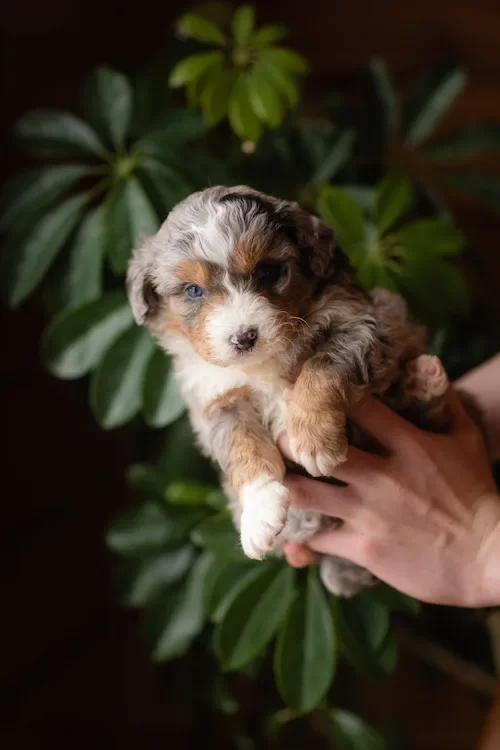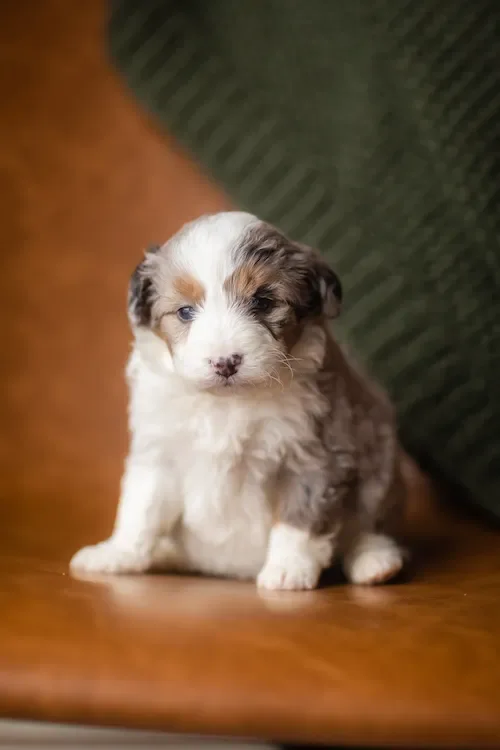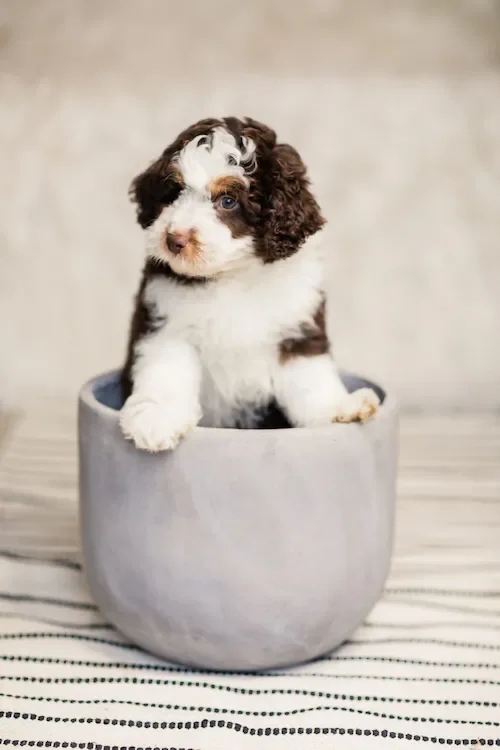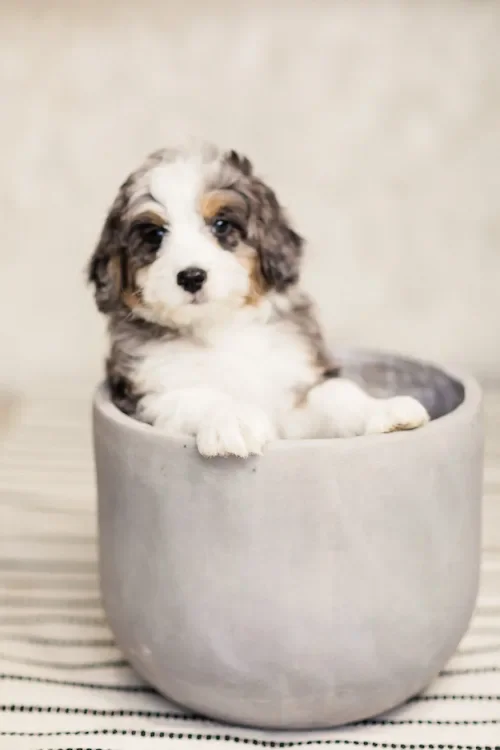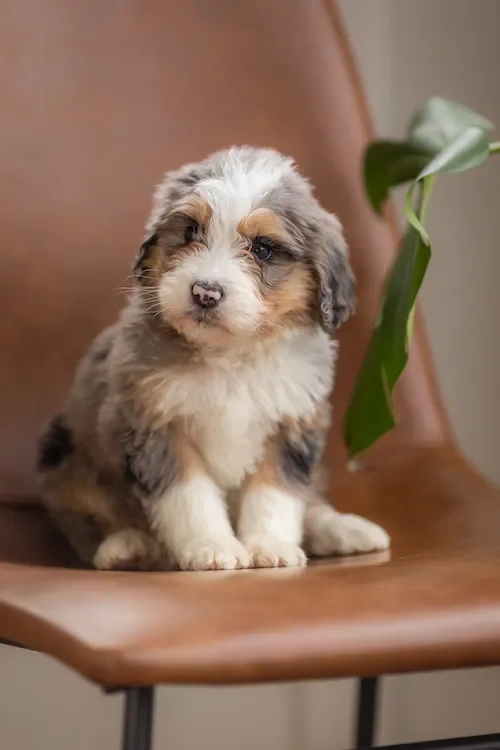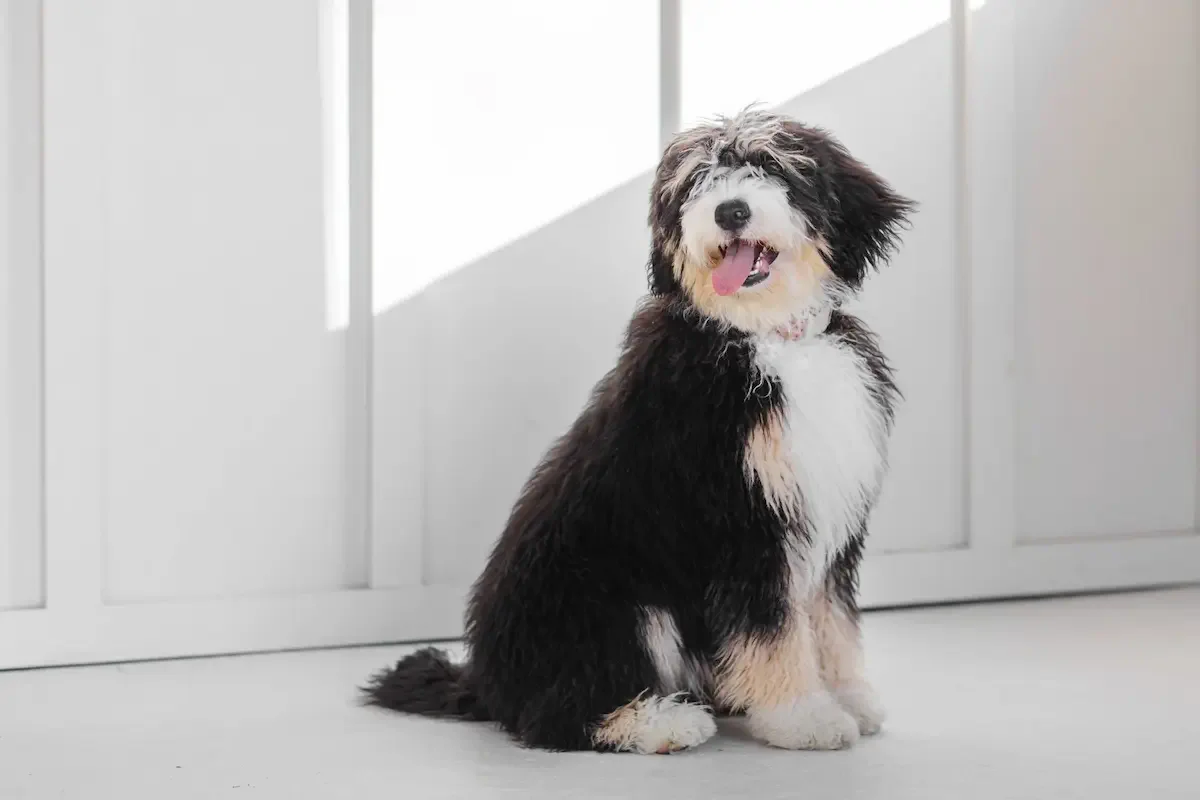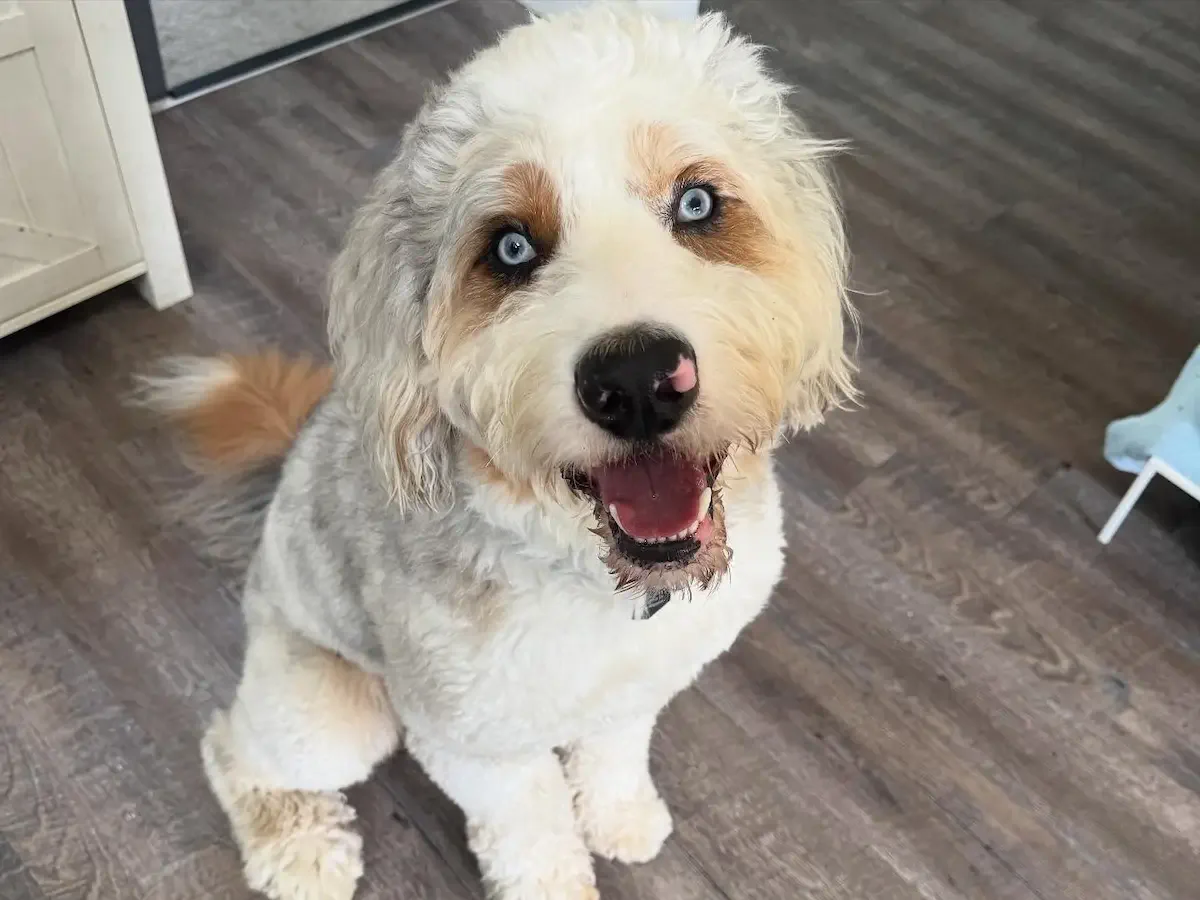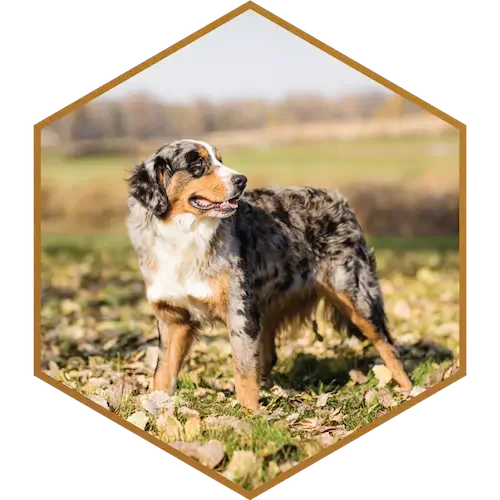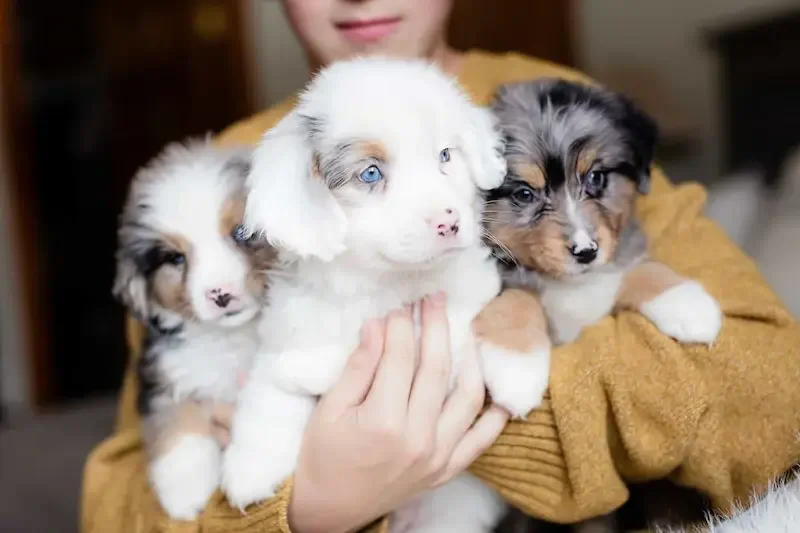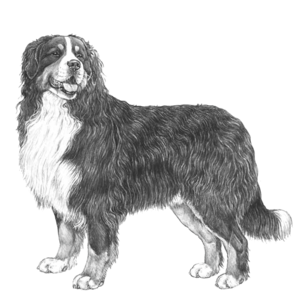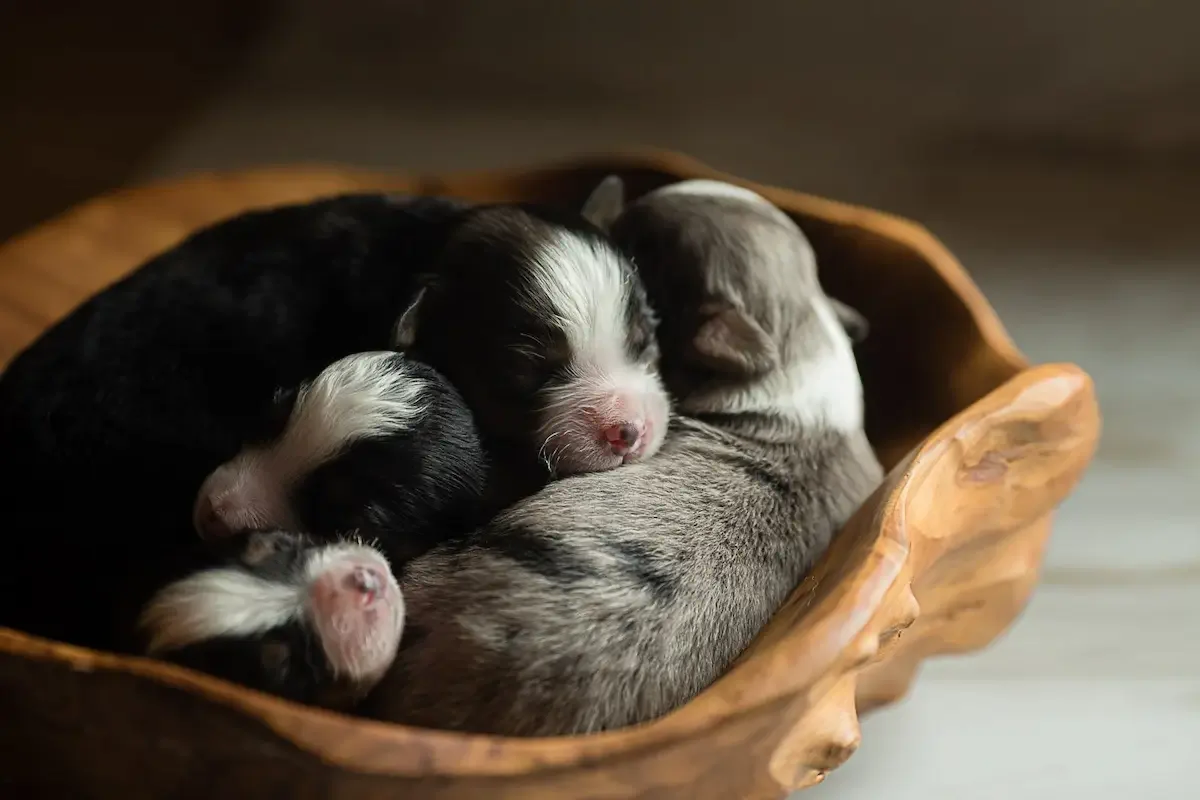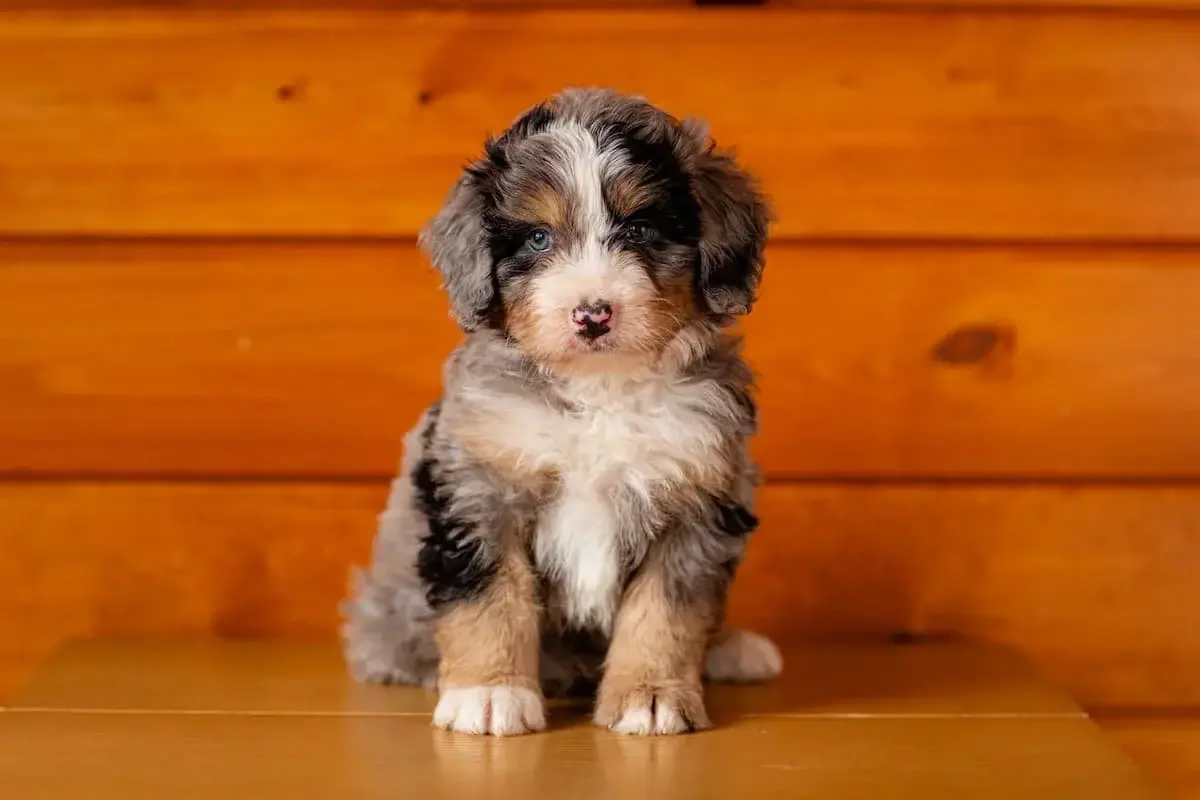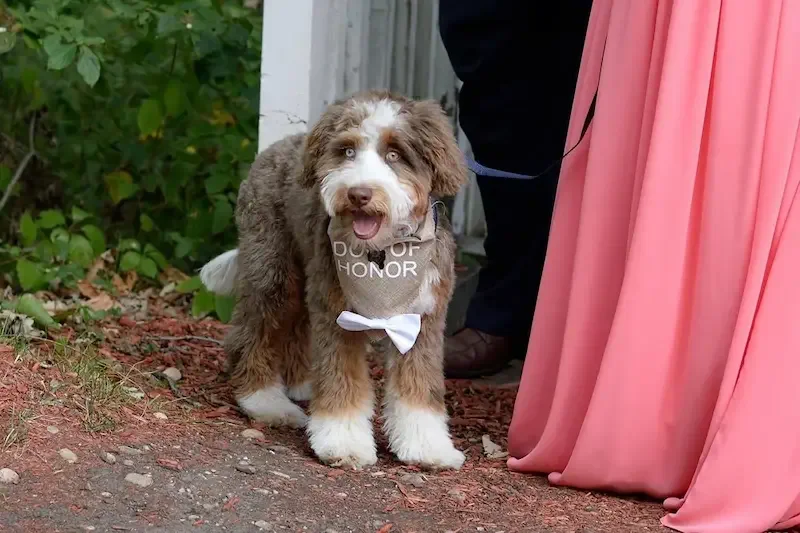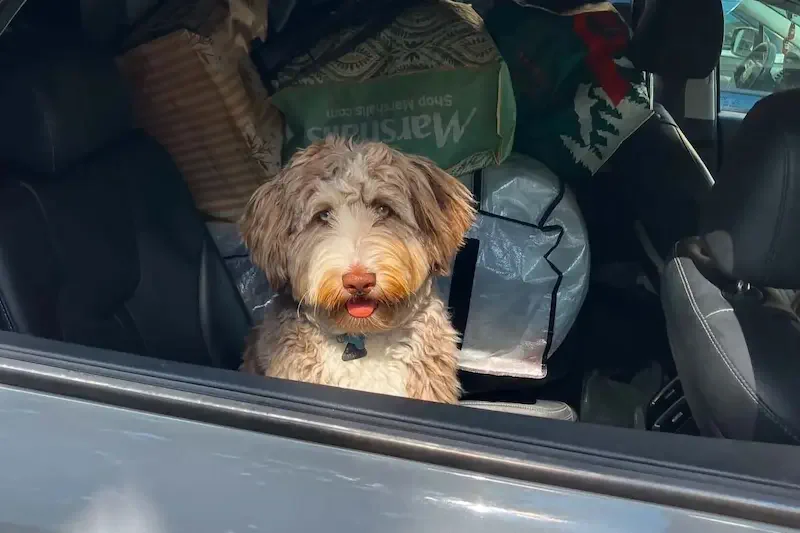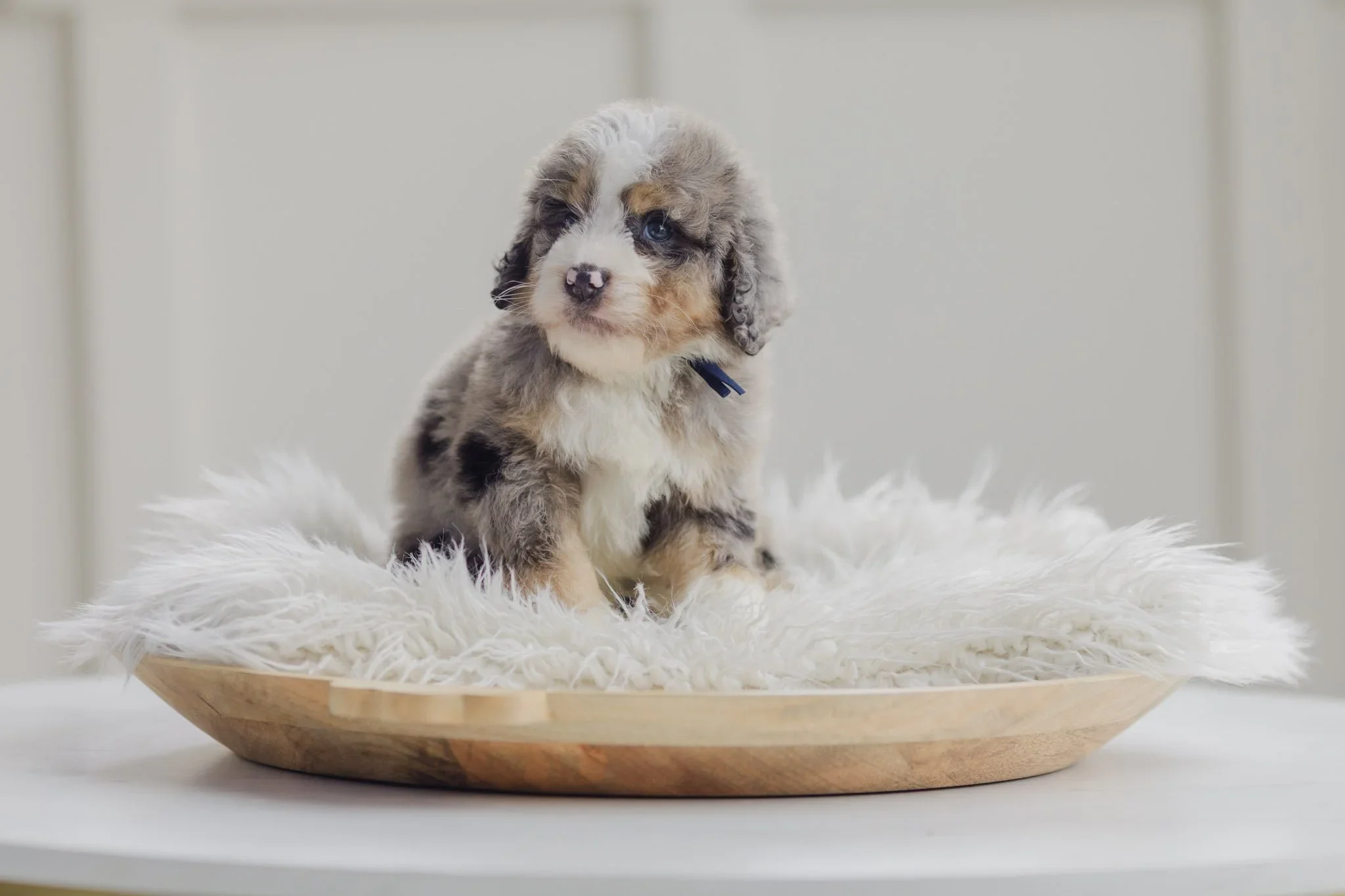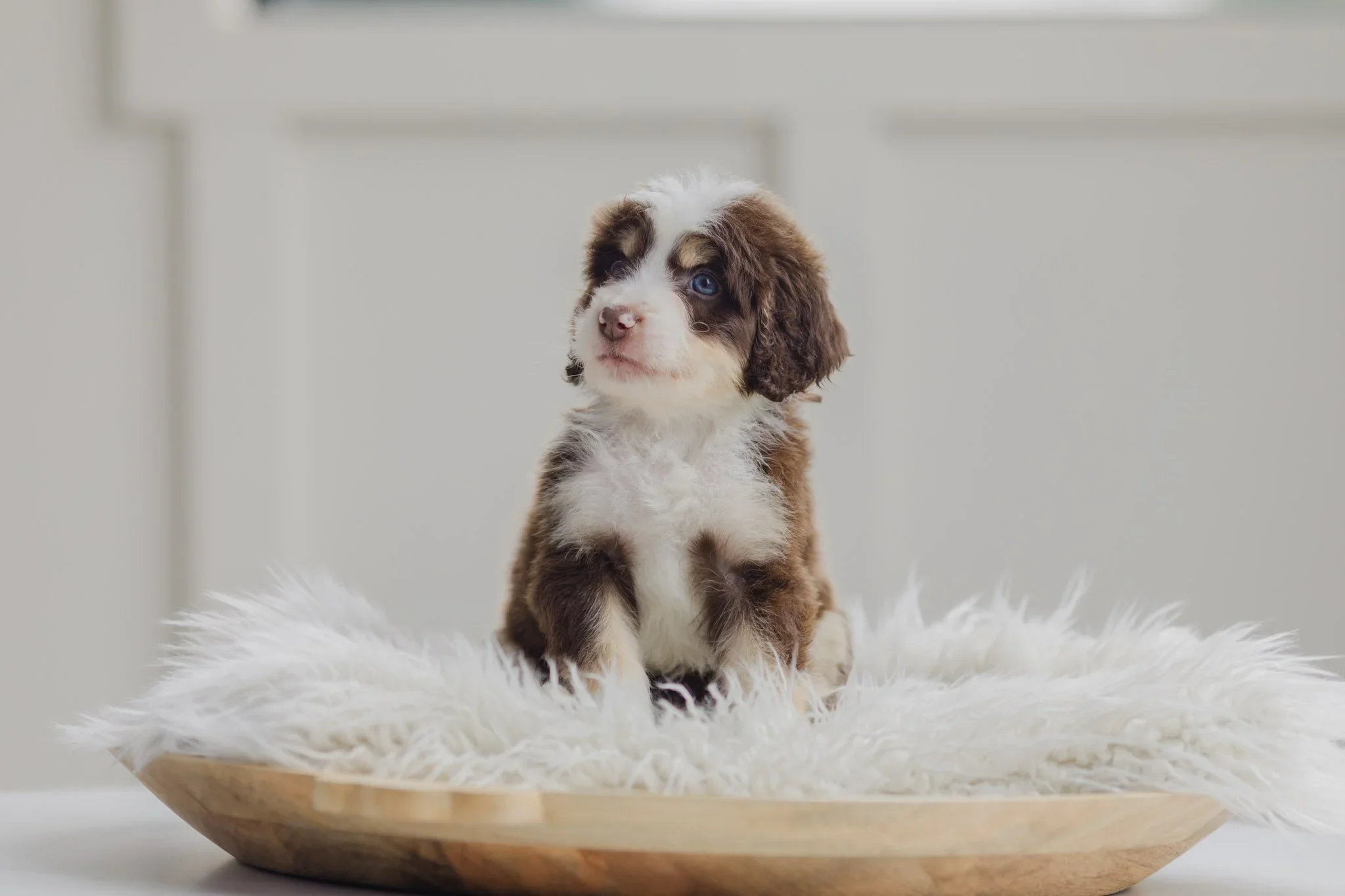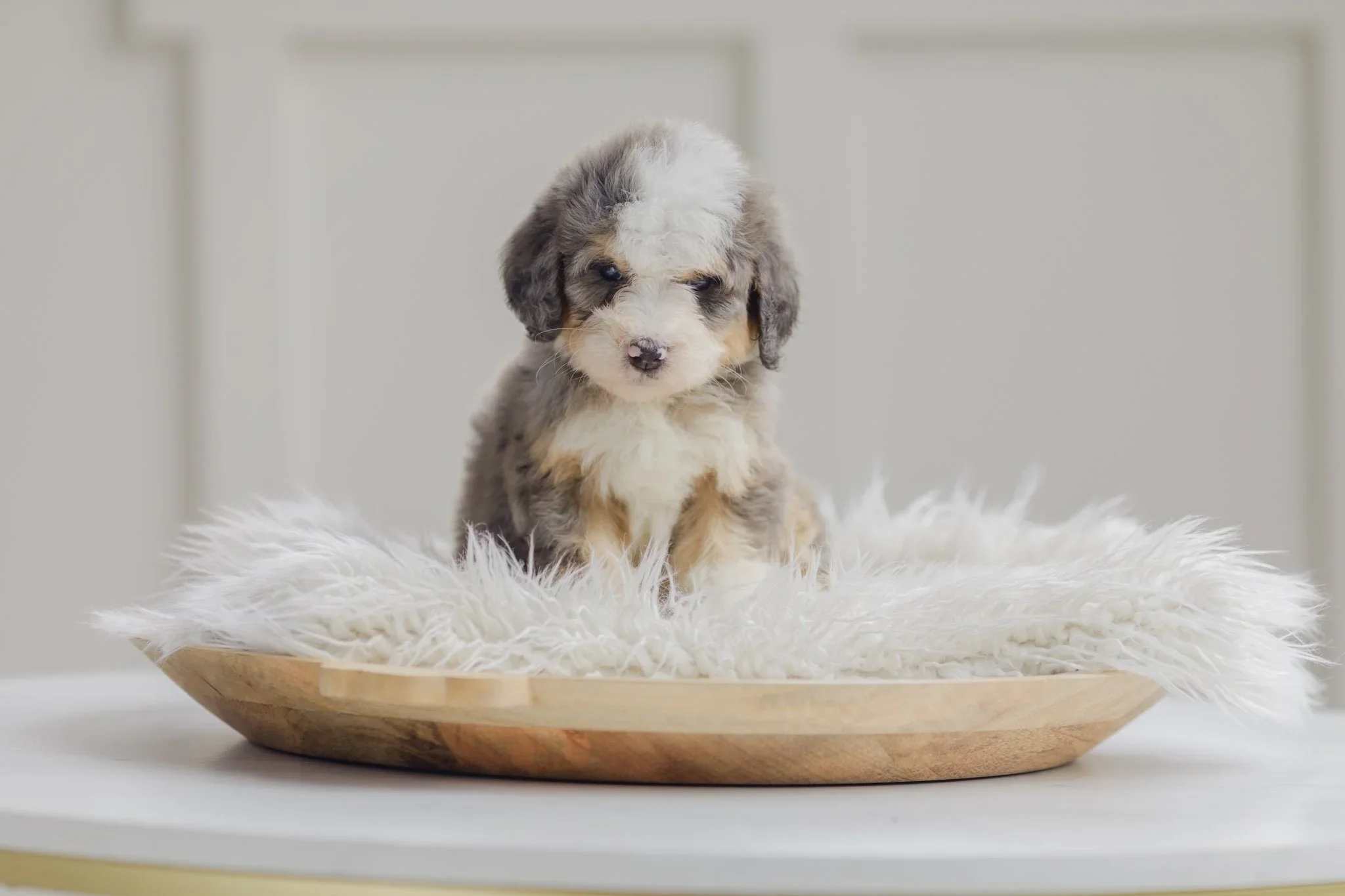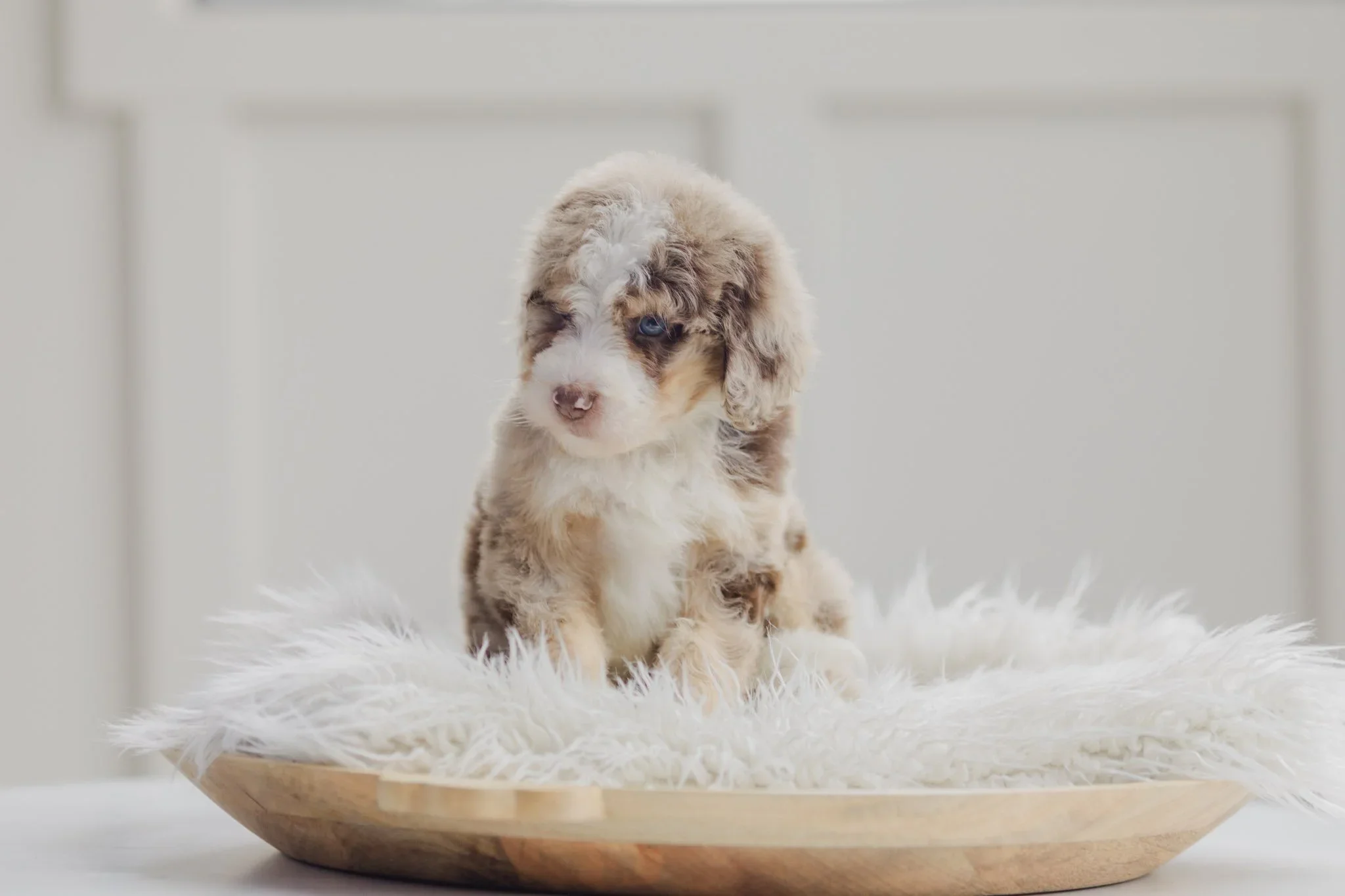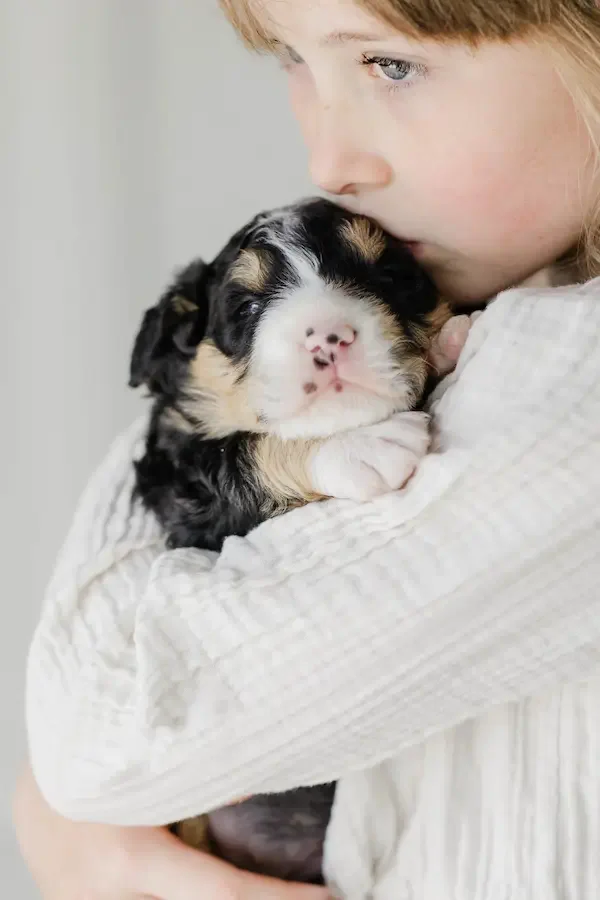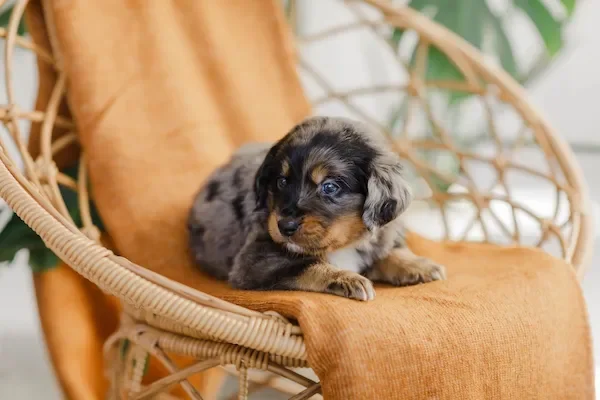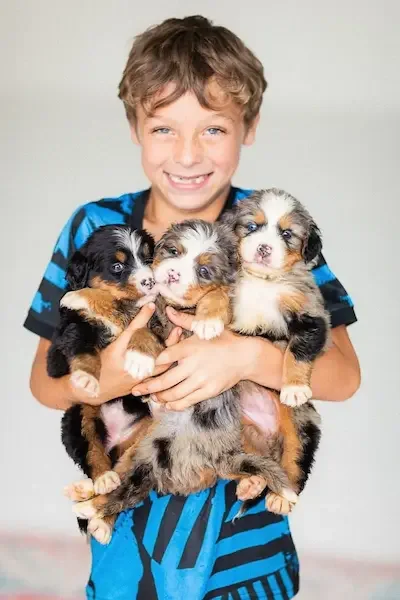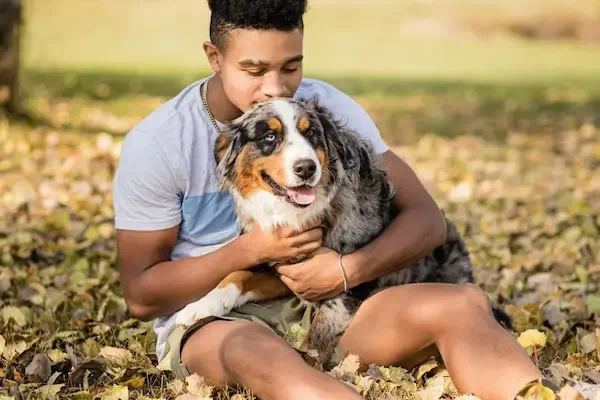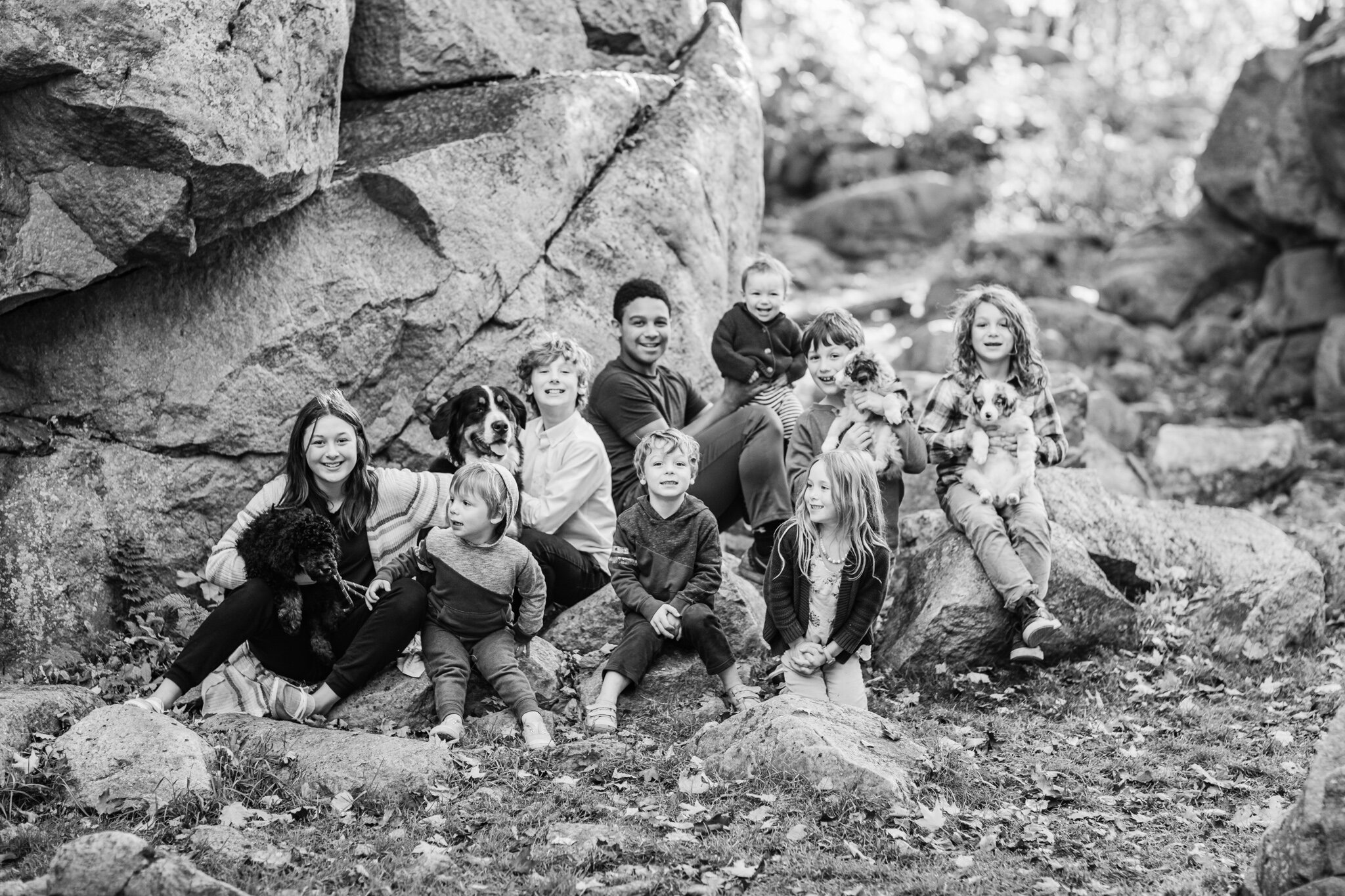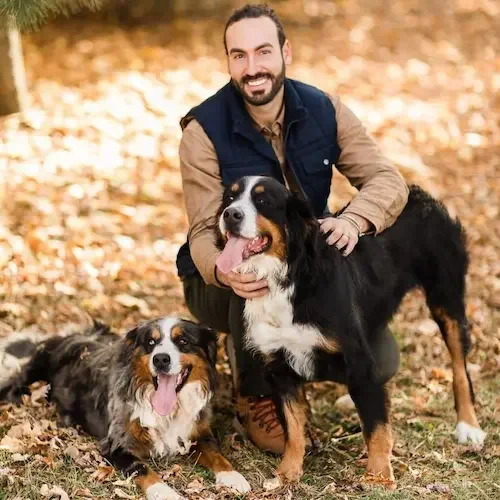Australian Mountain Doodles: “Hypoallergenic” and Loyal
“Aussiebernedoodle” “Swiss doodle” “Aussie Mountain Doodle” “Australian Bernedoodle”
The Australian Mountain Doodle (also called Aussie Mountain Doodle or Swiss Doodle) combines Poodle, Bernese Mountain Dog, and Australian Shepherd, creating an intelligent, allergy-friendly companion with balanced energy and a calm, loyal nature.
“Bernese Mountain Dog, Australian Shepherd, and Poodle hybrid- intelligent, loyal, eager to please, easy to train, medium energy level, therapy and service dog potential, mellow, social and outgoing.”
“Smart, Gentle, and Hypoallergenic.”
Best Suited For: Active families seeking a loyal, intelligent, and low-shedding companion.
Quick Answers About Australian Mountain Doodles
Are Australian Mountain Doodles hypoallergenic?
Australian Mountain Doodles are low-shed, allergy-friendly dogs. No dog can be considered 100% hypoallergenic.
Learn more about their allergy-friendly coats
Are Australian Mountain Doodles good with kids?
Yes, they are gentle, loving, and patient, so they get along well with kids. They make good friends for children of any age.
See why they’re great family dogs
How much do Australian Mountain Doodles weigh on average?
Australian Mountain Doodles usually weigh between 50 and 75 pounds on average for standard size.
What is an Australian Mountain Doodle?
Adult Furnished Blue Merle Tri Tuxedo F1 Standard Australian Mountain Doodle
An Australian Mountain Doodle is a type of dog that comes from mixing a Poodle, Australian Shepherd, and Bernese Mountain Dog. The goal is to get a dog that is easy to train and does not shed much.
What is the temperament of an Australian Mountain Doodle?
Australian Mountain Doodles are known to be friendly and loyal dogs. They also get along well with people and are easy to live with.
Learn more about their temperament
How big do Australian Mountain Doodles get?
The size of Australian Mountain Doodles can come in micro, mini, medium, standard and toy sizes.
What colors and coat types can Australian Mountain Doodles have?
Aussie Mountain Doodles can come in shades like black, white, cream, brown, or grey with curly, wavy, or straight coats.
Get to know more about the different colors and coat types
What is the average lifespan of an Australian Mountain Doodle?
The average Australian Mountain Doodle can generally live for 12 to 15 years, with ages varying based on size and care.
Learn more about the Australian Mountain Doodle lifespan
Are Australian Mountain Doodles trainable and what is their energy level?
Australian Mountain Doodles are quite easy to train, and they learn things quickly.
What does an Australian Mountain Doodle look like?
Australian Mountain Doodles are medium to large dogs with wavy or curly coats that come i colors like black, brown, or cream. They have warm eyes and soft, floppy ears that make them look friendly and easy to be around.
The F1, F2, F2B, F3, and multigenerational Australian Mountain Doodle puppies being held by a young boy. Unfurnished Australian Mountain Dogs
Which breeds make up an Australian Mountain Doodle?
Australian Mountain Doodles are a mix of the Poodle, Bernese Mountain Dog, and Australian Shepherd.
Poodle
Poodles are the third breed parent of the Australian Mountain Doodle and are best known for their loyalty and eagerness to please their fur parents. As hunting and water dogs, poodles are naturally intelligent dogs who are easily trainable. According to Your Dogs World, poodle genes make up at least 50% of the Australian Mountain Doodle’s genetic makeup, the rest is equally shared by the Bernese Mountain Dog and Australian Shepherd.
Bernese Mountain Dog
Bernese Mountain Dogs are known to be gentle giants. This breed is ideal for working across the farms of Switzerland. Farmers loved this breed and often used them to herd or watch over their farm animals. As the second parent breed of the Aussie Mountain Doodles, the Bernese Mountain Dog gives triple cross doodles their gentle and calm nature.
Australian Shepherd
Its Australian Shepherd lineage makes it one of the most intelligent dog breeds out there and it is one of the three parent dog breeds of the Australian Mountain Doodle. As a preferred breed for herding sheep, the Australian Shepherd gives the Aussie Mountain Doodle a high intelligence and a strong love for running and playing.
What is the crossbreeding history of the Australian Mountain Doodle?
The Australian Bernese Mountain Doodle is a mix that started because many people wanted a Doodle mixed with the smart nature and strong work drive of the Australian Shepherd.
Developed mostly in Australia and North America, breeders wanted to make a dog that would be great for both being a friend and doing jobs. These dogs are not only good family pets, but they can also be great service or therapy dogs with the right
What do F1, F1B, F2, F2B, F3, and multigenerational Australian Mountain Doodles mean?
F1, F1B, F2, F2B, F3, and multigenerational Australian Mountain Doodles are the different generations of breeding. Each of these has its own traits when it comes to coat, size, and temperament.
Breeder-standard terminology; outcomes vary. Each Australian Mountain Doodle is different, and no specific breed generation is guaranteed to have a specific size or coat.
Australian Mountain Doodle puppies with different coats types and colors sleeping.
Australian Mountain Doodle Generational Breakdown
| Generation | Genetic Makeup | Coat Type | Temperament | Best Suited For |
|---|---|---|---|---|
| F1 | 50% Bernese, 25% Poodle, 25% Australian Shepherd | Wavy to straight, moderate shedding | Strong build, calm, loyal | Families wanting hybrid vigor and Bernese traits |
| F1B | 75% Poodle, 12.5% Bernese, 12.5% Australian Shepherd | Curlier, allergy-friendly, low shedding | Intelligent, affectionate, easy to train | Allergy-sensitive homes, first-time doodle owners |
| F2 | Cross between two F1s (50% Poodle, 25% Bernese, 25% Australian Shepherd) | Wide variety: straight, wavy, or curly | Friendly, adaptable, variable traits | Families comfortable with coat/size variety |
| F2B | ~62.5% Poodle, 18.75% Bernese, 18.75% Australian Shepherd | Wavy to curly, consistent low-shedding | Highly trainable, calm, gentle | Great therapy/service potential with training; structured families |
| F3 | 60–75% Poodle, balanced Bernese/Australian Shepherd | Predictable wavy or curly, low shedding | Adaptable, steady, intelligent | Families wanting predictability |
| Multigen | Multiple generations beyond F2/F3 | Consistent low-shedding | Calm, loyal, social, stable | Allergy-sensitive families, companion homes |
What are the key personality traits of Australian Mountain Doodles?
Australian Mountain Doodles are known for being smart, loving, loyal, friendly, calm, and also very easy to adjust to new things.
Here's a quick breakdown of the key traits:
Activity Level - Moderate to High
Calm Nature - High
Intelligence - High
Exercise Needs - Balanced
Family Friendly - High
Allergy-Friendly - High
Trainability - High
Maintenance and Grooming Needs - High
Shedding - Low
Socialization Needs - Moderate to High
Brown tri color Australian Mountain Doodle at Stokeshire Designer Doodles in Wisconsin.
Australian Mountain Doodle puppy sitting upright at Stokeshire Designer Doodles in Wisconsin.
What Should I know about Aussie Mountain Doodle Personalities?
Here are the most important questions people should have answered about the personality characteristics of Australian Mountain Doodles:
Are Aussie Mountain doodles calm dogs?
Yes, Aussie Mountain Doodles are calm dogs. They like to be around people and get along well with others. They can be easy-going, but they also love to run and play with kids and other pets.
Are Aussie Mountain Doodles smart?
Aussie Mountain Doodles are smart dogs. They can learn things fast. It is easy to teach them new commands, and they do well with different ways of training.
What is the Aussie Mountain Doodle temperament like?
Aussie Mountain Doodles are friendly and loyal. They also fit in well with many places and people. These dogs love to play, but they can be calm too. That is why they are good for families who want a close companion.
What is an Australian Mountain Doodle’s Energy Level?
Australian Mountain Doodles have a good balance when it comes to energy. They like to get daily exercise and play with people. At the same time, they can sit and relax quietly with their families.
Are Australian Mountain Doodles good family pets?
Little girl smiling and holding an Australian Mountain Doodle puppy showing how good they are with kids.
Yes, Australian Mountain Doodles get along well with kids and other pets. They make a good family pet because they are kind and loving. They build a strong connection with their families and their other pets.
Full grown Australian Mountain Doodle with brown and white coloring at Stokeshire Designer Doodles in Wisconsin.
How big are Aussie Mountain Doodles?
Australian Mountain Doodles can be 12 to 29 inches tall and weigh 10 to 100 pounds.
How Big is a Full-Grown Australian Mountain Doodle?
A full-grown Australian Mountain Doodle can weigh about 95 pounds. A normal or standard-size dog like this may be around 28 inches tall.
How big do mini Australian Mountain Doodles get when fully grown?
Mini Aussie Mountain Doodle can get up to 22 inches tall. It will weigh less than half of the standard-size dog.
What are the different sizes of Australian Mountain Doodles?
Australian Mountain Doodles come in different sizes. You can get one that is standard full-grown, medium mini, or toy/micro size.
Full Grown Australian Mountain Doodle from Stilly x Rico Red/Brown Merle Tri
Australian Mountain Doodle Sizes & Growth Stages
| Size Type | Age Group | Height | Weight |
|---|---|---|---|
| Toy/Micro | Puppy | 6–9 in | 3–6 lbs |
| Toy/Micro | Adolescent | 9–13 in | 6–12 lbs |
| Toy/Micro | Full Grown | 12–18 in | 10–24 lbs |
| Mini | Puppy | 8–10 in | 5–10 lbs |
| Mini | Adolescent | 12–15 in | 15–25 lbs |
| Mini | Full Grown | 17–20 in | 25–35 lbs |
| Medium | Puppy | 9–11 in | 7–12 lbs |
| Medium | Adolescent | 13–17 in | 20–35 lbs |
| Medium | Full Grown | 18–22 in | 35–50 lbs |
| Standard | Puppy | 11–14 in | 10–20 lbs |
| Standard | Adolescent | 16–22 in | 35–65 lbs |
| Standard | Full Grown | 23–29 in | 50–100 lbs |
Australian Mountain Doodle Height in Inches by Age Group
Australian Mountain Doodle Weight in Pounds by Age Group
What type of coat does an Australian Mountain Doodle Have?
Australian Mountain Doodles can have wavy, curly, straight, furnished, or unfurnished coats.
-
The curly coats make the Swiss Doodles stand out. These curls look stylish, feel soft, and the fur can hold onto dander and dirt. This helps many people with allergies. It is a good choice for those who get sneezy around dogs.
-
Bernese Aussie Doodles with wavy coats have an easy charm because of their soft waves. This kind of coat is easy to take care of, but you should brush it often to keep it looking and feeling good. The waves also give the dog a fun and bouncy look that makes them very cute.
-
Furnished coats give the Aussie Mountain Doodle a special look. You can see longer hair on the face and legs. This coat makes them look royal and helps keep them safe from the weather. You should groom them often to keep the hair neat and nice. A clean coat helps show off their good looks.
-
Unfurnished coats in Bernese Aussie Doodles are easy to tell apart because the fur is shorter and smoother all over the dog's body. These coats are usually easy to care for. This means they work well for people who want a simple grooming job.
What colors and patterns do Australian Mountain Doodles have?
Australian Mountain Doodles come in many coat colors, including merle, brindle, bi-color, tri-color, phantom, phantom merle, tuxedo, parti, mismark, and merle tri.
-
The Aussie Bernese Poodle Mix with a tuxedo pattern has strong, dark colors and white spots that stand out. The tuxedo coat will almost always have white on the chest and on the paws.The Aussie Bernese Poodle Mix with a tuxedo pattern has strong, dark colors and white spots that stand out. The tuxedo coat will almost always have white on the chest and on the paws.
-
Tri-color Aussie Mountain Doodles have three colors in their coat. You can see the main color, which may are black or brown. There is also white on the body, and a lighter color, like tan or cream. This mix of colors helps the dog stand out and look bright and lively.Tri-color Aussie Mountain Doodles have three colors in their coat. You can see the main color, which may are black or brown. There is also white on the body, and a lighter color, like tan or cream. This mix of colors helps the dog stand out and look bright and lively.
-
The phantom pattern in this breed is a bold mix of two colors. Most of the time, one of the colors stands out more. This rare style has a main coat color. Then, there are smaller spots that show up on places like the dog’s eyebrows, cheeks, legs, and chest. This mix makes the dog stand out and draws people’s eyes right away.The phantom pattern in this breed is a bold mix of two colors. Most of the time, one of the colors stands out more. This rare style has a main coat color. Then, there are smaller spots that show up on places like the dog’s eyebrows, cheeks, legs, and chest. This mix makes the dog stand out and draws people’s eyes right away.
-
Phantom Merle coats in Australian Mountain Doodles show off the bold phantom pattern in a new way. The merle gene makes the colors mix together, giving the dog a look with swirls. You may see styles like blue or chocolate mixed with cream. This mix helps to bring out different colors and layers in how they look.Phantom Merle coats in Australian Mountain Doodles show off the bold phantom pattern in a new way. The merle gene makes the colors mix together, giving the dog a look with swirls. You may see styles like blue or chocolate mixed with cream. This mix helps to bring out different colors and layers in how they look.
-
Mismarked Australian Mountain Doodles have patterns that are different from the usual coat styles. This coat color is made up of splashes of new and different colors or markings. It makes each dog stand out as one of a kind. The best thing about a mismark is that you never know how it will look. No two dogs are the same.Mismarked Australian Mountain Doodles have patterns that are different from the usual coat styles. This coat color is made up of splashes of new and different colors or markings. It makes each dog stand out as one of a kind. The best thing about a mismark is that you never know how it will look. No two dogs are the same.
-
The Parti pattern in Aussie Mountain Doodles shows big color patches. It often has a bright main color with white mixed in. This look may have deep colors, like black or chocolate, with clear bits of tan or cream.The Parti pattern in Aussie Mountain Doodles shows big color patches. It often has a bright main color with white mixed in. This look may have deep colors, like black or chocolate, with clear bits of tan or cream.
-
The Merle Tri pattern in this breed is a mix of three clear colors that really get your attention. This style often has a main merle color. There are also bright spots of another color and strong white marks mixed in.The Merle Tri pattern in this breed is a mix of three clear colors that really get your attention. This style often has a main merle color. There are also bright spots of another color and strong white marks mixed in.
-
The Bi-Color pattern in Aussie Mountain Doodles has two main colors that stand out, like the blue merle pattern. Most of the time, one color is stronger and acts as the main background. The other color pops out more and looks different from the first. A few common color pairs include deep chocolate with cream or classic black with white.The Bi-Color pattern in Aussie Mountain Doodles has two main colors that stand out, like the blue merle pattern. Most of the time, one color is stronger and acts as the main background. The other color pops out more and looks different from the first. A few common color pairs include deep chocolate with cream or classic black with white.
-
Chocolate merle Swiss Doodles have a stunning coat that blends warm chocolate tones with marbled swirls of cream or lighter shades. This rare coloring not only makes them visually striking but also highlights the unique charm that sets doodles apart.Chocolate merle Swiss Doodles have a stunning coat that blends warm chocolate tones with marbled swirls of cream or lighter shades. This rare coloring not only makes them visually striking but also highlights the unique charm that sets doodles apart.
How do you care for an Australian Mountain Doodle?
Australian Mountain Doodles need daily grooming, a balanced diet, 60–90 minutes of exercise, early socialization, and positive reinforcement training to stay healthy and happy.
Little girl kissing Aussie Mountain doodle when concerned about it's health.
Quick pupdate: Watch an Australian Mountain Doodle sprint across the grass for a joyful fetch! Therapy‑grade temperament and family‑friendly energy from Stokeshire Designer Doodles.
What is the typical grooming requirement for an Australian Mountain Doodle?
Australian Mountain Doodles need to be brushed every day. You should groom them every 6 to 8 weeks. Clean their ears and trim their nails once a week. Give them a bath every 4 to 6 weeks.
How Do I Take Care of an Australian Mountain Doodle's Coat and Skin Health?
Be sure to check your pet's skin often. Look for any signs of irritation or allergies. Bath them on a regular basis with a good shampoo. It is also important to feed them food with omega fatty acids.
Do Australian Mountain Doodles shed?
Australian Mountain Doodles have coats that do not shed much. They lose less hair than other kinds of dogs.
Are Australian Mountain Doodles Hypoallergenic?
Australian Mountain Doodles are low-shed, allergy-friendly dogs. No dog is 100% hypoallergenic, but our puppies are bred to be very good for those with allergies. This means they make less dander and shed less hair than most other dog breeds.
What should I feed an Australian Mountain Doodle and what Portions?
Feed your dog a good and balanced diet. Make sure to give the right amount of food for their size, age, and the dog food brand you use. A normal meal plan might look like this:
Toy/Micro: Give about ¾ to 1¼ cups each day.
Mini: Give about 1 to 2 cups each day.
Medium: Give about 2 to 3 cups each day.
Standard: Give about 3 to 4 cups each day.
Try to eat foods that are high in protein and healthy fats. Use chicken, fish, or lamb as the main protein in your meals. Add some fruits and vegetables, too, as they give important vitamins and fiber.
How much exercise does an Australian Mountain Doodle need each day?
Australian Mountain Doodles should get at least 60 to 90 minutes of exercise every day.
The general rule for giving an Australian Mountain Doodle puppy exercise is simple. Allow 5 minutes of planned exercise for each month of age. You can do this up to two times a day.
When should I socialize an Australian Mountain Doodle puppy?
Australian Mountain Doodles should be socialized when they are between 3 and 14 weeks with positive, varied experiences to build confidence and prevent anxiety.
Are Aussie Mountain Doodles good for first time owners?
Aussie Mountain Doodles are great for first-time owners thanks to their friendly, intelligent, and adaptable nature.
What health issues are commonly seen in Australian Mountain Doodles?
Australian Mountain Doodles can develop health problems like hip troubles, cataracts, skin issues or allergies, and being overweight.
Other problems can include some health issues that come from their parents, like epilepsy and heart problems. It is important to have routine health checks. These can help you find and treat any problems early. A good diet and regular exercise are also important for your dog's health.
How does Stokeshire reduce health risks in Australian Mountain Doodles?
At Stokeshire, we use advanced genetic testing to help our breeding program. We also pick the right pairs and pay close attention to the size of the dogs. This helps to lower health risks in our Swiss Doodles.
We focus on mini and medium-sized dogs. This can help lower the chances of joint problems, like hip dysplasia. We also do health checks on all of our dogs. This helps us avoid pairing dogs that could pass on serious health issues.
What is the average lifespan of an Australian Mountain Doodle?
Australian Mountain Doodles usually live about 12 to 15 years; this varies based on the size and care of the Doodle.
Unfurnished Aussie Bernedoodle Puppy at 4 weeks
-
Toy Australian Mountain Doodles are the smallest of this breed. They can live up to 16 years. Their small size can help them have fewer health problems. They are usually quicker and active too.
-
Mini Australian Mountain Doodles usually live for about 12 to 15 years. This dog is not too big and not too small. The breed does well when it has enough exercise and people to be with.
-
Medium Australian Mountain Doodles usually live from 10 to 14 years. Their strong bodies help them stay healthy if they get good care. This includes enough exercise and a healthy diet.
-
Standard Australian Mountain Doodles usually live for about 10 to 13 years. Because they are bigger, they may get some health problems. It is good to take them to the vet often and help them stay healthy. This is important for this big triple-cross dog breed.
How do Australian Mountain Doodles compare to Bernedoodles, Goldendoodles, and Aussiedoodles?
Australian Mountain Doodles are good because they mix smarts, strength, and coats that don't shed much. They are a stronger and calmer dog when you compare them to Aussiedoodles. If you want a dog that has more energy than Bernedoodles or Goldendoodles, they also give you that.
Doodle Breed Comparison
| Breed | Parent Mix | Temperament & Activity | Coat & Shedding | Best For… |
|---|---|---|---|---|
| Australian Mountain Doodle | Poodle + Bernese Mountain Dog + Australian Shepherd | Intelligent, balanced energy, affectionate, and adaptable | Wavy or curly, low-shedding, allergy-friendly | Families wanting a versatile, allergy-friendly, family-focused dog |
| Bernedoodle | Poodle + Bernese Mountain Dog | Calm, gentle, loyal, with lower energy levels | Wavy or curly, low-shedding | Owners seeking a laid-back, cuddly companion |
| Aussiedoodle | Poodle + Australian Shepherd | Very energetic, agile, and high-drive | Wavy or curly, moderate shedding | Active families or agility enthusiasts |
| Goldendoodle | Poodle + Golden Retriever | Friendly, playful, high-energy, social | Wavy to curly, low-shedding (varies) | Families wanting a friendly, active companion |
A boy holding Australian Mountain Dog puppies, wondering which one to pick.
Why choose an Australian Mountain Doodle over other Doodles?
Highly Intelligent & Trainable – Be easy to teach and quick to learn. Do well in being obedient and good at moving around courses.
Loyal & Social – Make strong ties with families. Be good with children.
Low to Moderate Shedding – A good choice for people who feel itchy or sneeze around shedding dogs.
Great Therapy Dog Potential – With appropriate training, can be a good dog for therapy and service work.
Versatile Size Options – You can get this breed in Mini, Medium, and Standard sizes.
Ready to meet your match? See available Australian Mountain Doodle Puppies
Are you looking for an Australian Mountain Doodle puppy? We raise and care for beautiful Swiss Doodles by hand. Our puppies can be delivered to many places in the U.S. and Mexico.
Stokeshire Designer Doodles is Wisconsin’s premier breeder of Australian Mountain Doodles. Here’s what sets us apart:
✔ Ethical, Health-Tested Breeding Program - All parents are genetically tested for health & temperament.
✔ Puppy Training & Socialization - Early Neurological Stimulation (ENS) & sound desensitization + Potty Training Protocol
✔ Personalized Matching Process - Helping families find the best puppy for their lifestyle.
✔ Transparent Pricing & Contracts - No hidden fees, just quality puppies & service.
Take a look at our cute Australian Mountain Doodle puppies and find the perfect companion for your family!
Young man sitting with full grown Australian Mountain Doodle at Stokeshire Designer Doodles in Wisconsin.
Australian Mountain Doodle FAQs
-
You have found them! At Stokeshire, we raise the healthiest and happiest puppies for your family!
We bring puppies to homes all over the United States and even into Mexico. You can fill out your puppy application today if you want to reserve your perfect Aussie Mountain Doodle.
-
Australian Mountain Doodles get bigger fast. They reach most of their grown-up size by the time they are six months old. By eighteen months, they fill out and are at their full size.
-
Yes, Australian Mountain Doodles are able to live in apartments or houses. They know how to be playful, but they can also be calm when inside.
-
Their kind nature, quick mind, and strong wish to make people happy make them a good potential choice for therapy and service with appropriate training.
-
Australian Mountain Doodles start at $3,500 (and up). Final price varies by size, training, color/markings, and availability.
-
Yes, we are in Wisconsin, and we send our Aussie Mountain Doodles to people all over the U.S. and in Mexico. We offer nationwide delivery through flight nanny and ground delivery options. You can ask us about the ways we get the puppies to places like Chicago, Minneapolis, Madison, and more.
Still Looking for the Right Puppy for Your Family?
Stokeshire family of expert Doodle breeders sitting with Australian Mountain Doodle dogs and puppies in Wisconsin.
The Stokeshire family are expert Doodle breeders. They sit with Australian Mountain Doodle dogs and puppies in Wisconsin.
Sign up for our email waitlist. Our team will let you know when the right puppy is ready for you. You will get updates so you can find the perfect puppy at the right time.
About the Author and Breeder: James Stokes of Stokeshire Designer Doodles
Top Doodle dog breeder James Stokes sitting with Australian Mountain Doodle in Wisconsin near Stokeshire Designer Doodles.
James Stokes is the founder of Stokeshire Designer Doodles. He is a trusted breeder in Wisconsin. For over ten years, James has worked hard to raise healthy doodles that are great for families. He works with his wife and kids. Together, they have helped more than 650 families in the U.S. and Mexico get the perfect puppy.
At Stokeshire, all our Australian Mountain Doodles are:
Health-tested puppies that come with a two-year genetic guarantee
Hand-raised in a family home. They are never kept in kennels.
Socialized early with ENS, sounds, and family time to help them feel at ease.
Lovingly matched so each puppy fits well with the family’s way of life and needs.
James thinks that doodles are more than just pets. He feels they are friends for life. He wants to raise dogs that are smart. These dogs should feel good and fit in well with a family. They should also be good for people who have allergies.
Stokeshire is in Medford, Wisconsin. They take puppies to people all over the country and to Mexico. The transport is safe and stress-free.


